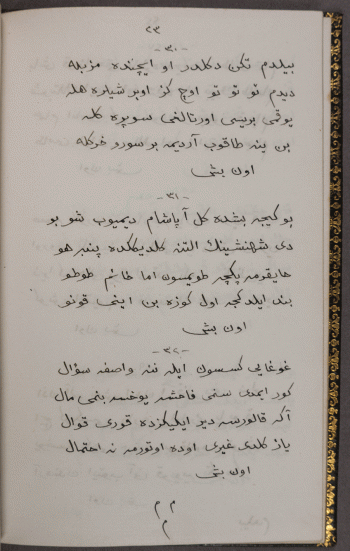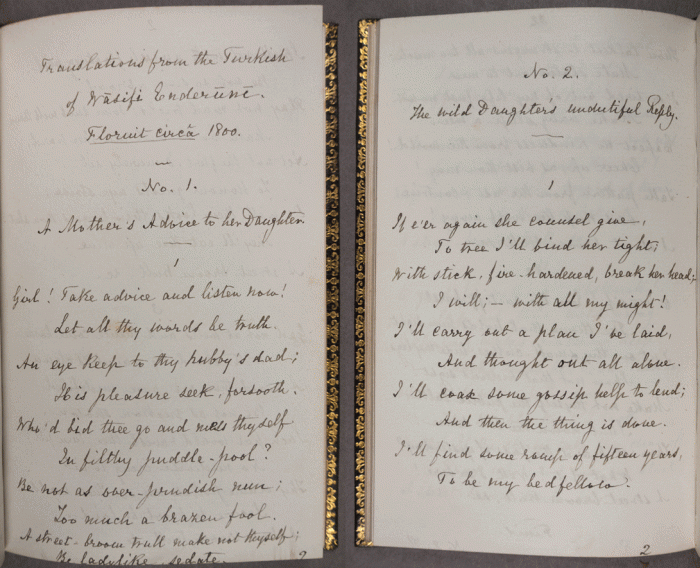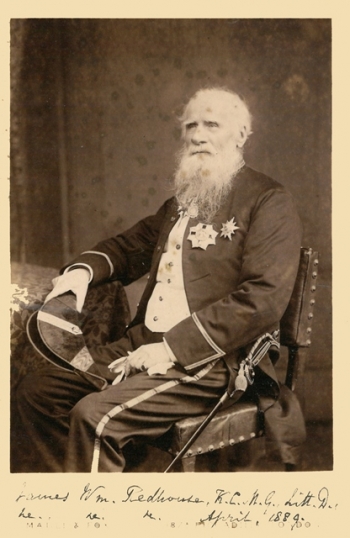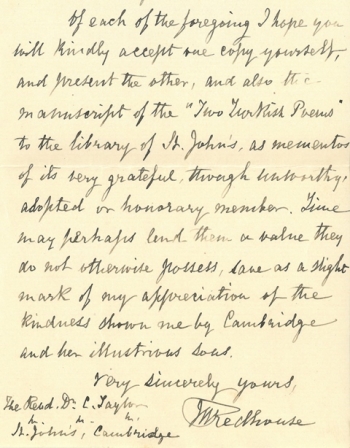From a harem in Constantinople to St John's
 Unexpected things can turn up in manuscript collections. The manuscript known as Browne 1436 is a case in point. This manuscript contains two humorous Turkish poems with an English verse translation by Sir James William Redhouse (1811-92). He published his translation anonymously in 1881. The poems were written by the celebrated Turkish poet, Wasif Bey. Uniquely amongst his works, they are written in the local dialect, as spoken by women of the lower middle classes in the harem in Constantinople, and are full of contemporary colloquialisms and the traditional proverbs popularly employed in local speech. The first of the two poems gives a mother’s advice to her young daughter as she approaches maturity, the second is the “Wild daughter’s undutiful reply”. It certainly is undutiful, as she declares that if her mother offers her any more advice, she’ll tie her to a tree and beat her to death, before going to find some 15 year old romp to be her bedfellow! Redhouse’s somewhat free verse translation attempts to capture the humour and style of the Turkish original, which some critics have described frankly as doggerel. This copy, whether the original manuscript or not, is in Redhouse's own hand. It comprises a preface, the Turkish text in Arabic characters, and the English verse translation.
Unexpected things can turn up in manuscript collections. The manuscript known as Browne 1436 is a case in point. This manuscript contains two humorous Turkish poems with an English verse translation by Sir James William Redhouse (1811-92). He published his translation anonymously in 1881. The poems were written by the celebrated Turkish poet, Wasif Bey. Uniquely amongst his works, they are written in the local dialect, as spoken by women of the lower middle classes in the harem in Constantinople, and are full of contemporary colloquialisms and the traditional proverbs popularly employed in local speech. The first of the two poems gives a mother’s advice to her young daughter as she approaches maturity, the second is the “Wild daughter’s undutiful reply”. It certainly is undutiful, as she declares that if her mother offers her any more advice, she’ll tie her to a tree and beat her to death, before going to find some 15 year old romp to be her bedfellow! Redhouse’s somewhat free verse translation attempts to capture the humour and style of the Turkish original, which some critics have described frankly as doggerel. This copy, whether the original manuscript or not, is in Redhouse's own hand. It comprises a preface, the Turkish text in Arabic characters, and the English verse translation. 
In his preface, Redhouse warns the reader what to expect:
“It must not for a moment be supposed that the poet has intended to depict a 'lady' of his country. His verses are a Dickens or a Wilkie Collins-like portraiture of Turkish lower middle-class feminine vulgarity, expressed in the peculiar phraseology of women; who, from having no access to the refining influences of mixed and educated society, form a world of their own, with narrow ideas and a low tone of diction, from which the spread of knowledge can alone have the chance to emancipate them.”
 So how did the comic poetry of a Constantinople harem end up here? Redhouse did not attend St John’s as an undergraduate, indeed his only formal education was received at the mathematical school at Christ’s Hospital in London, which prepared its pupils for maritime careers. Left fatherless at five, he entered this institution as a small boy, but was expelled for truancy in his early teens. The precise details of Redhouse’s early career are somewhat hazy. He appears to have travelled as a cabin-boy on a merchant ship to Constantinople, where he jumped ship, and entered Ottoman service. There he rapidly acquired an extraordinary range of language skills. By his own accounts within a few years of his arrival he had acquired proficiency in Turkish, Persian, Arabic, French and Italian, and had begun the study of modern Greek and German: skills which he deployed in various diplomatic and translation posts. By the mid-nineteenth-century Redhouse was producing his first linguistic publications; his Grammaire raisonnée de la langue ottomane was published in 1846, and the Müntahabat-i Lügat-i Osmaniye, containing Ottoman definitions of widely used Arabic and Persian words, was finished in 1842 and published anonymously a decade later. Subsequent editions appeared under Redhouse’s name, and it continued to be used in Ottoman schools for years. Returning to England for health reasons, Redhouse took up the post of oriental translator in the Foreign Office, and found greater opportunities to publish. His pocket manual of colloquial Ottoman and a small dictionary brought him to the attention of the American Mission who financed a major Lexicon of English and Turkish (1861), aimed at Turkish-speakers. Its success led to a commission to produce a Turkish-English dictionary which appeared in 1890, and a century later was still regarded as the most complete Ottoman dictionary ever published. His grammar and lexicon remain on the open shelves in the linguistics section of the working library: a useful reference tool for students even today.
So how did the comic poetry of a Constantinople harem end up here? Redhouse did not attend St John’s as an undergraduate, indeed his only formal education was received at the mathematical school at Christ’s Hospital in London, which prepared its pupils for maritime careers. Left fatherless at five, he entered this institution as a small boy, but was expelled for truancy in his early teens. The precise details of Redhouse’s early career are somewhat hazy. He appears to have travelled as a cabin-boy on a merchant ship to Constantinople, where he jumped ship, and entered Ottoman service. There he rapidly acquired an extraordinary range of language skills. By his own accounts within a few years of his arrival he had acquired proficiency in Turkish, Persian, Arabic, French and Italian, and had begun the study of modern Greek and German: skills which he deployed in various diplomatic and translation posts. By the mid-nineteenth-century Redhouse was producing his first linguistic publications; his Grammaire raisonnée de la langue ottomane was published in 1846, and the Müntahabat-i Lügat-i Osmaniye, containing Ottoman definitions of widely used Arabic and Persian words, was finished in 1842 and published anonymously a decade later. Subsequent editions appeared under Redhouse’s name, and it continued to be used in Ottoman schools for years. Returning to England for health reasons, Redhouse took up the post of oriental translator in the Foreign Office, and found greater opportunities to publish. His pocket manual of colloquial Ottoman and a small dictionary brought him to the attention of the American Mission who financed a major Lexicon of English and Turkish (1861), aimed at Turkish-speakers. Its success led to a commission to produce a Turkish-English dictionary which appeared in 1890, and a century later was still regarded as the most complete Ottoman dictionary ever published. His grammar and lexicon remain on the open shelves in the linguistics section of the working library: a useful reference tool for students even today.
 Redhouse’s extraordinary contribution to the field of linguistics brought him academic recognition. In 1884, the University of Cambridge awarded Redhouse an honorary LittD, and he was admitted to St John’s. It was in this year that he presented his manuscript poetic translation to St John’s College, writing to Dr Charles Taylor, the then Master, that he was giving copies of his works to the Master and to the Library “as mementos of its very grateful, though unworthy, adopted or honorary member”.
Redhouse’s extraordinary contribution to the field of linguistics brought him academic recognition. In 1884, the University of Cambridge awarded Redhouse an honorary LittD, and he was admitted to St John’s. It was in this year that he presented his manuscript poetic translation to St John’s College, writing to Dr Charles Taylor, the then Master, that he was giving copies of his works to the Master and to the Library “as mementos of its very grateful, though unworthy, adopted or honorary member”.
This Special Collections Spotlight article was contributed on 26 May 2015 by Kathryn McKee, Special Collections Librarian.